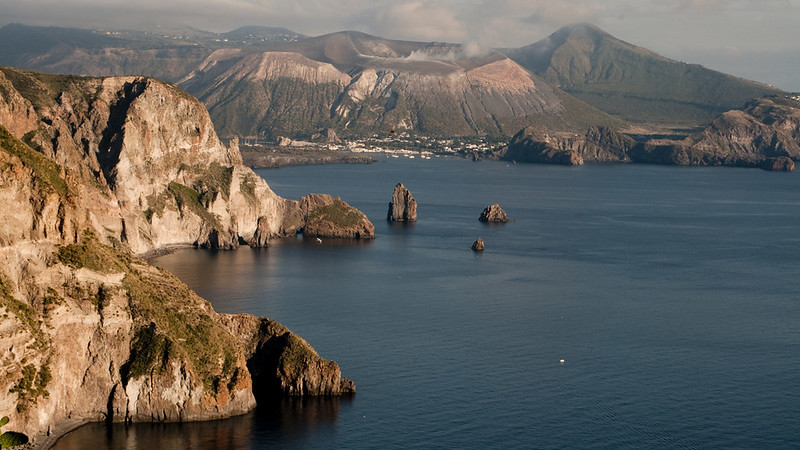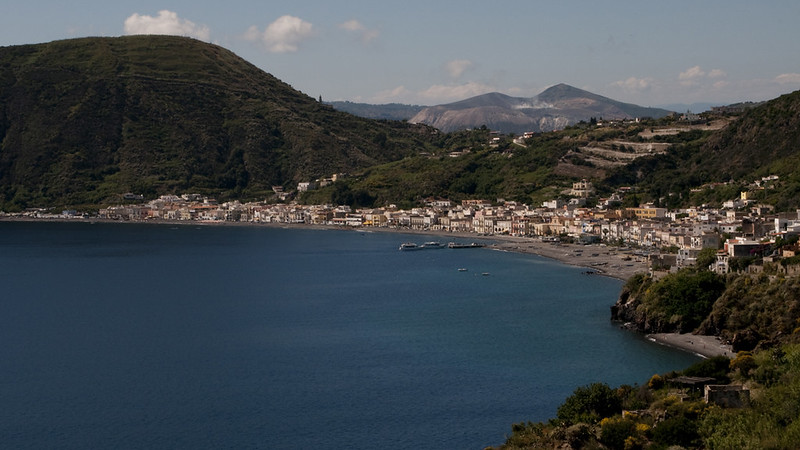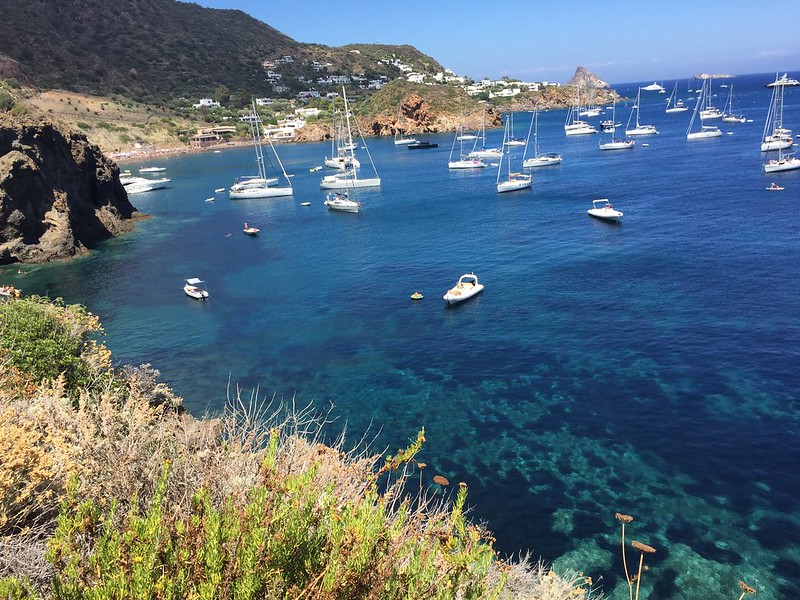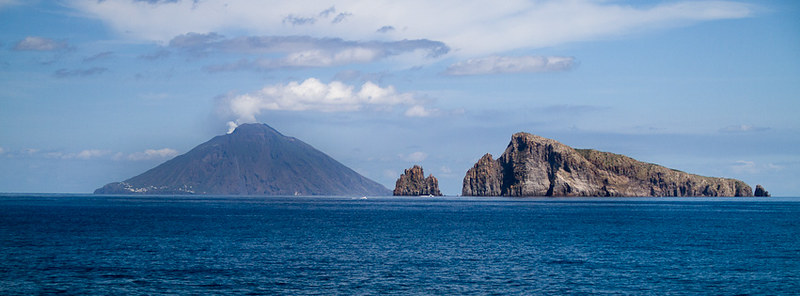Scattered through the turquoise waters off the coast of northeastern coast of Sicily, the UNESCO-listed Aeolian Islands are not known to many international travelers. But these seven tiny volcanic outposts—Vulcano, Lipari, Salina, Panarea, Stromboli, Filicudi and Alicudi—have been a favorite holiday escape for Italians for decades, who are drawn to their idyllic coastlines lined with pristine beaches, dramatic hikeable volcanos, charming resort towns, and relaxed island pace.
Each island in the archipelago offers something unique: Lipari and Salina are the largest and liveliest, with plenty of hotels, beaches, and dining options, as well as easy ferry links from both Sicily and the Italian mainland. Stromboli and Vulcano are natural paradises, with their chuffing volcanos crisscrossed by hiking trails, bubbling thermal mud baths, and black-sand beaches. Chic Panarea is Sicily’s answer to Capri, offering upscale dining and exclusive boutiques. Finally, Filicudi and Alicudi are as about as off the beaten track you can be in Italy.
For an island-hopping adventure in Italy, the Aeolian archipelago offers a little something for everyone and draws a fraction of the summer crowds of other popular islands like Capri, Ischia, Elba. You can catch a ferry to the islands from the ports of Naples or Reggio Calabria on the mainland or from Messina, Milazzo, or Palermo on Sicily. Otherwise, opt for a private speedboat or yacht transfer from these and other ports on Sicily or the mainland for more flexibility and the option of visiting more than one island on a single day trip.
Lipari
The largest and most accessible of the Aeolian Islands, Lipari draws the greatest number of visitors who either use it as a base to explore the entire archipelago or pop in for a quick day trip—it’s just a 45-minute hydrofoil trip away from Milazzo. Much busier than its smaller, sleepier neighbors, the island has a main town (also called Lipari) with a bustling port lined with pastel-colored buildings where the lion’s share of hotels and restaurants are located. Outside town, the remainder of the island is a rugged landscape of windswept Mediterranean countryside encircled by cliffs towering above cobalt-blue waters.
You can rent a scooter to explore the historic and cultural attractions scattered across the island, including the Archaeological Museum inside town’s Norman citadel, the ruins of a Greek acropolis dating from the time of Magna Graecia, and the baroque Cathedral of San Bartolomeo. Lipari is also ideal for a day cruise skirting the coastline to take in tiny coves like Cala Fico and the beaches of Vinci, Valle Muria, Punta della Castagna, Papesca, and Capo Rosso.
Salina
Salina is the second largest island in the archipelago, named for the Lingua salt works (“saline”) on its southeastern corner and made famous as setting for the 1994 film “The Postman”. While the other Aeolian Islands are largely rugged volcanic terrain, Salina’s inland hills are blanketed with lush fern woods, fields of wildflowers, bright yellow brooms bushes, and neat vineyards— all thanks to the island’s abundant freshwater springs. The coastline is lined with soaring cliffs that rise straight from the Mediterranean below and its beaches are among the most beautiful of all seven islands.
Two volcanoes, now extinct, shaped Salina: Monte dei Porri and Monte Fossa delle Felci, the highest peaks in the archipelago. For centuries, these jagged barriers made it difficult to travel between the island’s villages of Pollara, Malfa, Santa Maria Salina, Lingua, and Rinella by land, so each still retains a distinct character today. The main port town is Santa Marina Salina; Pollara is known for its spectacular beach.
Panarea
Though Panarea is the smallest and lowest of the Aeolian Islands, you would never know it based on its outsized attitude. Exclusive (and expensive), this VIP destination attracts in-the-know celebrities and fashionistas who want all the luxury and nightlife of Capri without the riff-raff. The island’s tiny San Pietro harbor fills with yachts in the summer and the whitewashed streets hum with visitors browsing the high-end boutiques and relaxing over an aperitivo.
Panarea forms its own tiny archipelago with the nearby islets of Basiluzzo, Spinazzola, Lisca Bianca, Dattilo, Bottaro, Lisca Nera, and the rocky outposts of Panarelli and Formiche. If you book a private speedboat or yacht for the day, you can cruise around the entire clutch of islets or simply circle Panarea to take a dip at its stunning Cala Junco, Calcara, and Zimmari beaches.
Stromboli
The volcanic peak of Stromboli, the most active in Europe, wows with its frequent, spectacular eruptions, but even on its calm days, it chuffs with black ash that can be seen from kilometers away. Hiking and walking enthusiasts can climb its dramatic volcanic slopes with one of the guided groups—for safety reasons, visitors are not allowed to strike out on their own above the 400-meter (1,300-foot) mark. Most hikes leave in the late afternoon for the three-hour walk to reach the summit at sunset and view the fireworks from the crater as dusk falls. You can also opt to take in the volcano from afar at the Italian Navy Observatory at Punta Labronzo or visit the Sciara del Fuoco lava flow that runs down the volcano slopes into the sea.
Most visitors come to Stromboli to explore the volcano, but you can also take in the medieval village of San Vincenzo and its unique clutch of white houseboats the tiny fishing village of Ginostra that clings to the rocky coastal cliffs and is accessible only via a historic mule trail, and the massive Strombolicchio boulder—dislodged by a past eruptions—topped by the island’s large lighthouse.
Vulcano
One whiff of the sulfuric-tinged air on Vulcano and you know that the rumors of thermal mud baths must be true. This island is known for its lively geothermal activity, ranging from smoke clouds and vapor spouts to sulphuric—and therapeutic—mud baths. All this huffing and puffing gave rise to the ancient Greek legend that this island was home to blacksmiths of Hephaestus, the god of fire and forges.
The biggest draw on the island is the thick, dark brown, sulfurous mud that is naturally warmed to 29°C (84°F) and considered an effective treatment for rheumatism and skin conditions. Soak in the mud-tinged baths for a while (making sure to keep it out of your eyes and hair) then grab some soft mud from the bottom of the pool to apply to your face and body. Once it’s dry, wash it off and then head to the nearby hot springs and soak in the warm seawater pool. Be forewarned, however: both you and your swimwear are likely to smell of rotten eggs for a few days afterward!
Alicudi and Filicudi
The western-most islands in the Aeolian archipelago, Alicudi and Filicudi are ideal if you really want to get away from it all. These two isolated outposts are virtually untouched by modern development, with just a scattering of tiny villages and almost no roads or other infrastructure. Transportation is by boat or mule, days are marked by quiet hikes through the wild countryside or basking on the beach, and the only entertainment is the comings and goings of the local fishing boats. If this sounds like heaven, then these two islands are your Mediterranean paradise.
Filicudi is known for the excellent snorkeling along its rocky coastline and inside its sea grottoes, including the Scoglio della Fortuna and the Grotta del Bue. Alicudi is completely carless, so the only engines you’ll hear during your stay are from the boats moored in the clear blue waters along the coast.









